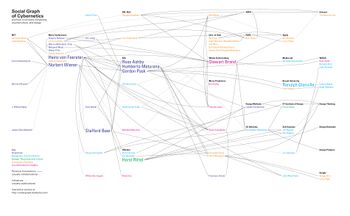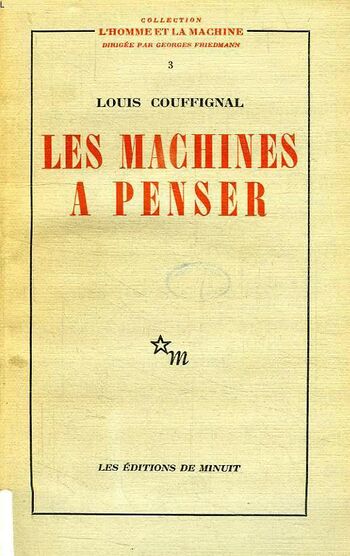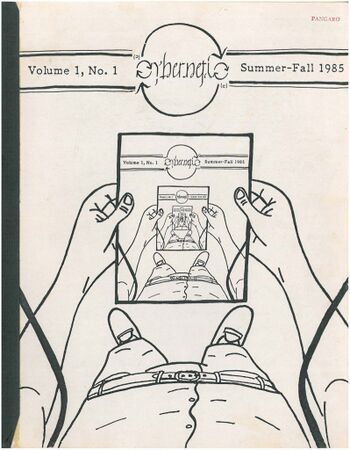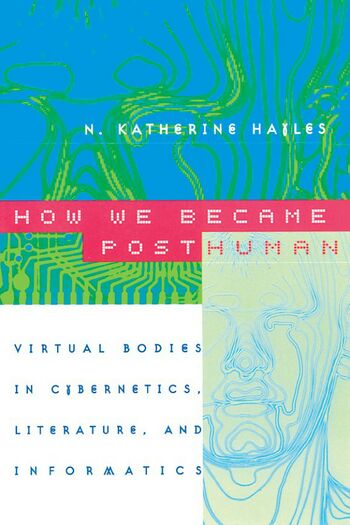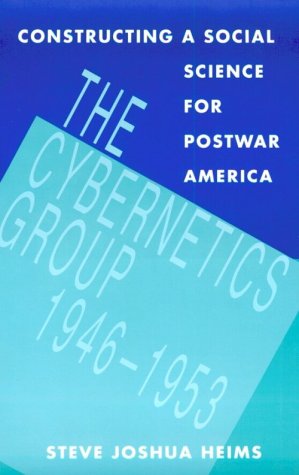Cybernetics
Jump to navigation
Jump to search

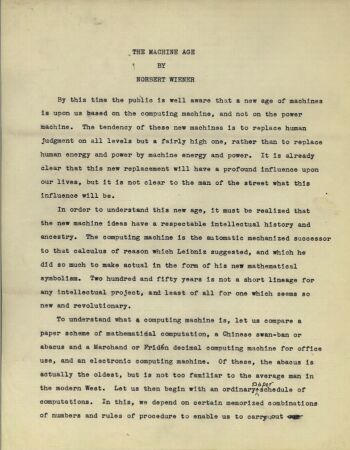
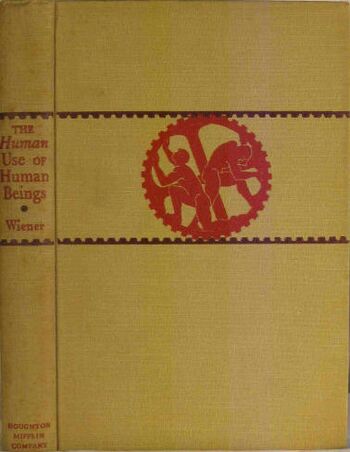
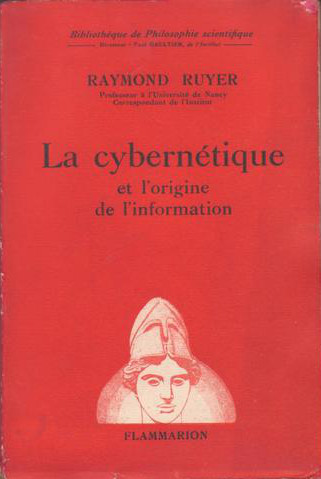
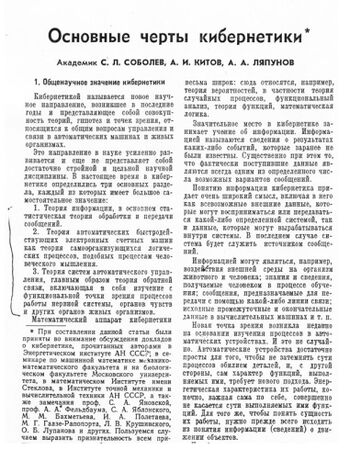

Bibliographical genealogy of cybernetics in the United States, France, the Soviet Union, and Germany in the 1940s and 1950s, and of second-order cybernetics since 1968, followed by a bibliography of its impact on the arts and sciences
Contents
- 1 Scholars
- 2 Publications
- 2.1 Wiener's cybernetics (1948)
- 2.2 Macy Conferences on Cybernetics (1946-1953)
- 2.3 Information theory and cybernetics in France (1950s)
- 2.4 Information theory and cybernetics in the Soviet Union (1950s)
- 2.5 Information theory and cybernetics in Germany (1950s)
- 2.6 Second-order cybernetics (1968-1975ff)
- 2.7 Historical analysis and review of the impact of cybernetics
- 2.8 Indirectly related prior work
- 2.9 Resources
- 2.10 Bibliographies
- 3 Links
- 4 See also
Scholars
Publications
Wiener's cybernetics (1948)

Norbert Wiener, Cybernetics: or Control and Communication in the Animal and the Machine, 1948. DJVU (Second edition, 1965).

Norbert Wiener, "The Machine Age", [1949]. PDF (v3).

Norbert Wiener, The Human Use of Human Beings: Cybernetics and Society, 1950. PDF (1989 edition).
- Norbert Wiener, The Extrapolation, Interpolation, and Smoothing of Stationary Time Series, NDRC Report, MIT, February 1942. Classified (ordered by Warren Weaver, then the head of Section D-2), printed in 300 copies. Nicknamed "Yellow Peril". Published in 1949 (see below). Shannon 1948 mentions it as containing "the first clear-cut formulation of communication theory as a statistical problem, the study of operations on time series. This work, although chiefly concerned with the linear prediction and filtering problem, is an important collateral reference in connection with the present paper" (p 626-7). [1], Commentary.
- Norbert Wiener, Cybernetics: or Control and Communication in the Animal and the Machine, Paris: Hermann & Cie, 1948; Cambridge, MA: Technology Press (MIT), 1948; New York: John Wiley & Sons, 1948, 194 pp; 2nd ed., MIT Press, and Wiley, 1961, 212 pp, PDF, ARG; repr., forew. Doug Hill and Sanjoy K. Mitter, MIT Press, 2019, xlvii+303 pp, EPUB. Reviews: Dubarle (1948, FR), Littauer (1949), MacColl (1950). In the spring of 1947, Wiener was invited to a congress on harmonic analysis, held in Nancy, France and organized by the bourbakist mathematician, Szolem Mandelbrojt. During this stay in France Wiener received the offer to write a manuscript on the unifying character of this part of applied mathematics, which is found in the study of Brownian motion and in telecommunication engineering. The following summer, back in the United States, Wiener decided to introduce the neologism ‘cybernetics’ into his scientific theory. According to Pierre De Latil, MIT Press tried their best to prevent the publication of the book in France, since Wiener, then professor at MIT, was bound to them by contract. As a representative of Hermann Editions, M. Freymann managed to find a compromise and the French publisher won the rights to the book. Having lived together in Mexico, Freymann and Wiener were friends and it is Freymann who is supposed to have suggested that Wiener write this book. Benoît Mandelbrot and Walter Pitts proofread the manuscript. [2]
- N. Viner (Н. Винер), Kibernetika, ili upravlenie i svyaz v zhivotnom i mashine [Кибернетика, или Управление и связь в животном и машине], trans. G.N. Povarov, Moscow: Sovetskoe radio [Советское радио], 1958, 216 pp; new ed., 1963; 2nd ed., 1968. (Russian)
- Kybernetik. Regelung und Nachrichtenübertragung in Lebewesen und Maschine, rororo, 1968; Econ, 1992. (German)
- La cybernétique. Information et régulation dans le vivant et la machine, trans. Ronan Le Roux, Robert Vallée and Nicole Vallée-Lévi, Paris: Seuil, 2014, 376 pp. [3] (French)
- more translations
- Norbert Wiener, "Cybernetics", Scientific American 179:5, Nov 1948, pp 14-19. Adapted from his 1948 book. [4]
- Norbert Wiener, The Extrapolation, Interpolation, and Smoothing of Stationary Time Series with Engineering Applications, Cambridge, MA: Technology Press (MIT), 1949; New York: John Wiley & Sons, 1949; London: Chapman & Hill, 1949; 2nd ed., MIT Press, 1966. Earlier printed as a classified NDRC "yellow peril" Report, MIT, 1942. Uses Gauss's method of shaping the characteristic of a detector to allow for the maximal recognition of signals in the presence of noise; later known as the "Wiener filter." Review: Tukey (1952).
- Norbert Wiener, "The Machine Age", [1949]. Unpublished. Written for The New York Times.
- Norbert Wiener, The Human Use of Human Beings: Cybernetics and Society, Boston, MA: Houghton Mifflin, 1950, 241 pp; 2nd ed., 1954; London: Eyre and Spottiswode, 1954; New York: Avon Books, 1967; New York: Da Capo Press, 1988; repr., intro. Steve J. Heims, London: Free Association Books, 1989, xxx+199 pp; new ed., 1990.
- Cybernétique et société: l'usage humain des êtres humains, Paris: Union Générale d'Éditions, 1952; 1971; repr., 2014. (French)
- Mensch und Menschmaschine, Frankfurt am Main: Metzner, 1952; 4th ed., 1972. (German)
- Kibernetika i obshchestvo [Кибернетика и общество], trans. E.G. Panfilov, Moscow: IIL, 1958, 200 pp. (Russian)
- more translations
Macy Conferences on Cybernetics (1946-1953)
- Cybernetics: Transactions of the Sixth Conference, New York: Josiah Macy, Jr. Foundation, 1949.
- Cybernetics: Transactions of the Seventh Conference, eds. Heinz von Foerster, Margaret Mead, and Hans Lukas Teuber, New York: Josiah Macy, Jr. Foundation, 1950.
- Cybernetics: Transactions of the Eighth Conference, eds. Heinz von Foerster, Margaret Mead, and Hans Lukas Teuber, New York: Josiah Macy, Jr. Foundation, 1952.
- Cybernetics: Transactions of the Ninth Conference, eds. Heinz von Foerster, Margaret Mead, and Hans Lukas Teuber, New York: Josiah Macy, Jr. Foundation, 1953.
- Cybernetics: Transactions of the Tenth Conference, eds. Heinz von Foerster, Margaret Mead, and Hans Lukas Teuber, New York: Josiah Macy, Jr. Foundation, 1955.
- Cybernetics | Kybernetik 1: The Macy-Conferences 1946–1953. Band 1. Transactions/Protokolle, ed. Claus Pias, Zürich/Berlin: Diaphanes, 2003, 736 pp. [5] [6] (German),(English)
- Cybernetics | Kybernetik 2: The Macy-Conferences 1946–1953. Band 2. Documents/Dokumente, ed. Claus Pias, Zürich: diaphanes, 2004, 512 pp. Introduction. [7] (German),(English)
- Cybernetics: The Macy-Conferences 1946-1953: The Complete Transactions, ed. Claus Pias, Zürich: Diaphanes, 2016, 734 pp.
Information theory and cybernetics in France (1950s)

Raymond Ruyer, La cybernétique et l'origine de l'information, 1954. PDF.
- Norbert Wiener, Cybernetics: or Control and Communication in the Animal and the Machine, Paris: Hermann & Cie, Cambridge, MA: Technology Press, and New York: John Wiley & Sons, 1948, 194 pp. Review: Dubarle (1948, FR).
- Dominique Dubarle, "Idées scientifiques actuelles et domination des faits humains", Esprit 9:18 (1950), pp 296-317. (French)
- Louis de Broglie (ed.), La Cybernétique: théorie du signal et de l'information, Paris: Éditions de la Revue d'optique théorique et instrumentale, 1951, 318 pp. Contributors include physicists and mathematicians Robert Fortet, M.D. Indjoudjian, A. Blanc-Lapierre, P. Aigrain, J. Oswald, Dennis Gabor, Jean Ville, Pierre Chavasse, Serge Colombo, Yvon Delbord, Jean Icole, Pierre Marcou, and Edouard Picault. [8] (French)
- Norbert Wiener, Cybernétique et société, l'usage humain des êtres humains [1950], Paris: Deux-Rives, 1952; 2nd ed., Paris: 10-18, 1962; 1971. (French)
- Louis Couffignal, Les machines à penser, Paris: Minuit, 1952, 153 pp; 2nd ed., rev., 1964, 133 pp. (French)
- Denkmaschinen, trans. Elisabeth Walther with Max Bense, intro. Max Bense, Stuttgart: Klipper, 1955, 186 pp; repr., 1965. (German)
- Colloques Internationaux du Centre National de la Recherche Scientifique 47 (1953). Proceedings of a congress held in Paris in January 1951. Paul Chauchard: the congress was "the first manifestation in France of the young cybernetics, with the participation of N. Wiener, the father of this science." For this congress, organised by the French scientists Louis Couffignal and Pérès, both of whom had visited the U.S. laboratories, and sponsored by the Rockefeller Foundation, a number of foreigners were invited, including Howard Aiken, Warren McCulloch, Maurice Wilkes, Grey Walter, Donald MacKay and Ross Ashby, along with Wiener who was staying in Paris for a couple of months at the Collège de France. 300 people attended; 38 papers were presented; 14 machines from six different countries were demonstrated. [9] (French)
- Pierre de Latil, La pensée artificielle: introduction à la cybernétique, Paris: Gallimard, 1953. (French)
- Thinking by Machine: A Study of Cybernetics, trans. Y.M. Golla, et al., London: Sidgwick & Jackson, 1956, xiii+353 pp; repr., Boston: Houghton Mifflin, 1957, 353 pp. (English)
- El Pensamiento artificial: introducción a la cibernética, trans. Alberto Luis Bixio, Buenos Aires: Losada, 1958, 366 pp. (Spanish)
- O Pensamento artificial: introdução a cibernetica, trans. Jeronimo Monteiro, São Paulo: Ibrasa, 1959; 2nd ed., 1968, 337 pp; 3rd ed., 1973. (Brazilian Portuguese)
- Il pensiero artificiale : introduzione alla cibernetica, trans. Delfo Ceni, Milan: Feltrinelli, 1962, 397 pp. (Italian)
- Benoît Mandelbrot, Contributions à la théorie mathématique des jeux de communications, Institut de Statistiques de l'Université de Paris 2, 1953. Ph.D. dissertation in mathematics making a connection between game theory and information theory. He showed for instance that both thermodynamics and statistical structures of language can be explained as results of minimax games between ‘nature’ and ‘emitter’. He also made the connection between the definitions of information given by the British statistician Ronald A. Fisher in the 1920s, by the physicist Dennis Gabor in 1946 and the already well-known definition proposed by Shannon. Mandelbrot was at MIT from 1952-1954 and later at the IAS in Princeton. [10] (French)
- Raymond Ruyer, La cybernétique et l'origine de l'information, Paris: Flammarion, 1954. (French)
- G.Th. Guilbaud, La cybernétique, Paris: PUF, 1954, 135 pp. (French)
- La Cibernética, Barcelona: Vergara, 1956, 225 pp. (Spanish)
- What Is Cybernetics?, trans. Valerie Mackay, London: Heinemann, 1959, 126 pp. (English)
- Cybernetik , Aldus/Bonniers, 1962, 104 pp; repr., 1966. (Swedish)
- Marcel-Paul Schützenberg, "Contributions aux applications statistiques de la théorie de l’information", Publications de l'Institut de Statistique de l'Université de Paris 3:1-2 (1954), pp 3-117; repr. in Œuvres complètes, Tome 3: 1953-1955, Paris: Institut Gaspard-Monge, Université Paris-Est, 2009, pp 56-161. Ph.D. Dissertation defended at the Faculté des Sciences in Paris in June 1953. (French)
- Paul Cossa, La cybernétique: du cerveau humain aux cerveaux artificiels, Paris: Masson, 1955, 98 pp; 2nd ed., rev., 1957, 102 pp. (French)
- Pol Kossa (Поль Косса), Kibernetika: «Ot chelovecheskogo mozga k mozgu iskusstvennomu» [Кибернетика: «От человеческого мозга к мозгу искусственному»], trans. P.K. Anokhin, Moscow: Izdatelstvo inostrannoy literatury, 1958, 122 pp. Trans. of 2nd ed. (Russian)
- Cibernética: del cerebro humano a los cerebros artificiales, Barcelona: Reverté, 1963, 74 pp. (Spanish)
- Marcel-Paul Schützenberg, "La théorie de l'information", in Cahiers d'actualité et de synthèse, Encyclopédie française, Paris: Société Nouvelle de l'Encyclopédie Française, 1957, pp 9-21. (French)
Information theory and cybernetics in the Soviet Union (1950s)

Liapunov, Kitov, Sobolev, "Osnovnye cherty kibernetiki", 1955. View online.

A.N. Kolmogorov, Teoriya peredachi informatsii, 1956. DJVU.
- Claude Shannon (Клод Шеннон), "Statisticheskaia teoriia peredachi elektricheskikh signalov" [Статистическая теория передачи электрических сигналов; The Statistical Theory of Electrical Signal Transmission] [1948], in Teoriya peredakhi elektrikheskikh signalov pri nalikhii pomekh [Теория передачи электрических сигналов при наличии помех], ed. Nikolai A. Zheleznov (А. Н. Железнов), Moscow: Izdatelstvo inostrannoi literatury (ИИЛ), 1953, pp 7-87. The editor rid the work of the words information, communication, and mathematical entirely, put entropy in quotation marks, and substituted data for information throughout the text. He also assured the reader that Shannon’s concept of entropy had nothing to do with physical entropy and was called such only on the basis of "purely superficial similarity of mathematical formulae". [11] (Russian)
- "Matematicheskaya teoriya svyazi" [Математическая теория связи] [1948], trans. S. Karpov, in Raboty po teorii informatsii i kibernetike [Работы по теории информации и кибернетике], Moscow: Izdatelstvo inostrannoi literatury (ИИЛ), 1963, pp 243-332. (Russian)
- Aleksei Liapunov, Anatolii Kitov, Sergei Sobolev, "Osnovnye cherty kibernetiki" [Основные черты кибернетики; Basic Features of Cybernetics], Voprosy filosofii [Вопросы философии] 141:4, Jul-Aug 1955, pp 136-148. The first Soviet article speaking positively about cybernetics and non-technical applications of information theory, authored by three specialists in military computing—Liapunov, a noted mathematician and the creator of the first Soviet programming language; Kitov, an organizer of the first military computing centers; and Sobolev, the deputy head of the Soviet nuclear weapons program in charge of the mathematical support. They presented cybernetics as a general "doctrine of information", of which Shannon’s theory of communication was but one part. The three authors interpreted the notion of information very broadly, defining it as "all sorts of external data, which can be received and transmitted by a system, as well as the data that can be produced within the system." Under the rubric of "information" fell any environmental influence on living organisms, any knowledge acquired by man in the process of learning, any signals received by a control device via feedback, and any data processed by a computer. [12] [13] (Russian)
- Ernst Kolman (Э. Кольман), "Chto takoe kibernetika?" [Что такое кибернетика?], Voprosy filosofii [Вопросы философии] 141:4, Jul-Aug 1955, pp 148-159; repr. in Filosofskiye voprosy sovremennoj fiziki [Философские вопросы современной физики], ed. I.V. Kuznetsov, Moscow: Gospolitizdat, 1958, pp 222-247. Lecture defending cybernetics, delivered at the Academy of Social Sciences in November 1954. (Russian)
- A.N. Kolmogorov (А. Н. Колмогоров), Teoriya peredachi informatsii [Теория передачи информации], Мoscow, 1956. (Russian)
- Ernst Kolman (Э. Кольман), Kibernetika [Кибернетика], Moscow: Znanie (Знание), 1956, 39 pp. (Russian)
- Claude Shannon (К.Э. Шеннон), John McCarthy (Дж. Маккарти) (eds.), Avtomaty. Sbornik statey [Автоматы. Сборник статей], trans. A.A. Liapunov, et al., Moscow: Izdatelstvo inostrannoy literatury (Издательство иностранной литературы), Nov 1956, 404 pp. Trans. of a collection of papers on automata theory, Automata Studies (Princeton University Press, 1956); with texts by John von Neumann, Marvin Minsky, Stephen Cole Kleene, et al. [14] (Russian)
- Igor’ A. Poletaev, Signal: O nekotorykh poniatiiakh kibernetiki [Сигнал: О некоторых понятиях кибернетики], Moscow: Sovetskoe radio, 1958, 413 pp. The first Soviet book on cybernetics. (Russian)
- Pol Kossa (Поль Косса), Kibernetika: «Ot chelovecheskogo mozga k mozgu iskusstvennomu» [Кибернетика: «От человеческого мозга к мозгу искусственному»] [1957], trans. P.K. Anokhin, Moscow: Izdatelstvo inostrannoy literatury, 1958, 122 pp. Trans. of 2nd ed. (Russian)
- A.N. Kolmogorov (А. Н. Колмогоров), "Kibernetika" [Кибернетика], in Bolshaya sovetskaya entsiklopediya, t. 51 [Большая советская энциклопедия], 2nd ed., Moscow: BSE (БСЭ), 1958, pp 149-151.
- Problemy kibernetiki [Проблемы кибернетики], ed. A.A. Glushkov (А.А. Ляпунов), et al., Moscow, 1958-1984. Journal. (Russian)
- Z.I. Rovenskiy (З.И. Ровенский), A.I. Uyemov (А.И. Уемов), Ye.A. Uyemova (Е.А. Уемова) (eds.), Mashina i mysl: filosofskiy ocherk o kibernetike [Машина и мысль: философский очерк о кибернетике], Moscow: Gospolitizdat (Госполитиздат), 1960, 143 pp. (Russian)
- O.B. Lupanov (ed.), Kiberneticheskiy sbornik, t. 1 [Кибернетический сборник], Mir (Мир), 1960, 289 pp, PDF. [15] (Russian)
- A.I. Berg (А.И. Берг) (ed.), Kibernetika na sluzhbe kommunizma. Sbornik statey [Кибернетика на службе коммунизма. Сборник статей], 1961, 312 pp. (Russian)
- Bibliography
- David Dinsmore Comey, "Soviet Publications on Cybernetics", Studies in Soviet Thought 4:2, 1964, pp 142-161. [16]
- Lee R. Kerschner, "Western Translations of Soviet Publications on Cybernetics", Studies in Soviet Thought 4:2, 1964, pp 162-177. [17]
Information theory and cybernetics in Germany (1950s)
- Nobert Wiener, Mensch und Menschmaschine [1950], trans. Gertrud Walther, Frankfurt am Main: Metzner, 1952, 211 pp; 4th ed., 1972. (German)
- Louis Couffignal, Denkmaschinen [1952], trans. Elisabeth Walther with Max Bense, intro. Max Bense, Stuttgart: Klipper, 1955, 186 pp; 1965. (German)
- Georg Klaus, "Vortrag über philosophische und gesellschaftliche Probleme der Kybernetik", 1957. Lecture. (German)
- Gotthard Günther, Das Bewusstsein der Maschinen: eine Metaphysik der Kybernetik, Krefeld, Baden-Baden: Agis, 1957; 2nd ed., 1963; 3rd ed. as Das Bewusstsein der Maschinen: eine Metaphysik der Kybernetik, mit einem Beitrag aus dem Nachlass: 'Erkennen und Wollen' , eds. Eberhard von Goldammer and Joachim Paul, Baden-Baden: Agis, 2002. [18] (German)
- Werner Meyer-Eppler, Grundlagen und Anwendungen der Informationstheorie, Berlin: Springer, 1959, xviii+446 pp; 2nd ed., eds. Georg Heike and K. Löhn, Berlin: Springer, 1969. Reviews: Tamm (1960), Billingsley (1961, EN), Adam (1965). (German)
- Georg Klaus, Kybernetik in philosophischer Sicht, East-Berlin: Dietz, 1961, 491 pp; rev ed., 1963; repr., 1965. Reviews: Stojanow (Deutsche Zeitschr Phil), Stock (Studies in Soviet Thought). (German)
- Георг Клаус, Kibernetika i filosofiya [Кибернетика и философия], trans. I.S. Dobronravov, A.P. Kupriyanov, and L.A. Leytes, Moscow: Изд. иностранной литературы, 1963, 530 pp. [19] (Russian)
- Cong zhe xue kan kong zhi lun [从哲学看控制论], trans. Zhi xue Liang, Beijing: Zhong guo she hui ke xue chu ban she, 1981, 462 pp. (Chinese)
Second-order cybernetics (1968-1975ff)
- Margaret Mead, "The Cybernetics of Cybernetics", in Purposive Systems: Proceedings of the First Annual Symposium of the American Society for Cybernetics, eds. Heinz von Foerster, John D. White, Larry J. Peterson, and John K. Russell, New York, NY: Spartan Books, 1968, pp 1-11. Excerpt. 1967 keynote address to the inaugural meeting of the American Society for Cybernetics (ASC). Mead had been a participant at the Macy Conferences, while this talk was a defining moment in the development of second-order cybernetics. She characterised "cybernetics as a way of looking at things and as a language for expressing what one sees". This paper was social and ecological in focus, with Mead calling on cyberneticians to assume responsibility for the social consequences of the language of cybernetics and the development of cybernetic systems. [20]. See also: Glanville 2015. [21]
- Humberto R. Maturana, Francisco J. Varela, De máquinas y seres vivos: una teoría sobre la organización biológica, trans. Carmen Cienfuegos, Santiago de Chile: Universitaria, 1972; 4th ed., Santiago de Chile: Universitaria, 1998, 137 pp. (Spanish)
- Autopoiesis and Cognition: The Realization of the Living, Dordrecht: Reidel, 1980, 141 pp.
- Autopoiesi e cognizione: la realizzazione del vivente, trans. Alessandra Stragapede, pref. Giorgio De Michelis, Venice: Marsilio, 1985. (Italian)
- De máquinas e seres vivos: autopoiese, a organização do vivo, Porto Alegre: Artes Médicas, 1997. (Brazilian Portuguese)
- Gordon Pask, Bernard Scott, "CASTE: A System for Exhibiting Learning Strategies and Regulating Uncertainties", International Journal of Man-Machine Studies 5:1, Jan 1973, pp 17-52. [22]
- Gordon Pask, Bernard Scott, D. Kallikourdis, "A Theory of Conversations and Individuals (Exemplified by the Learning Process on CASTE)", International Journal of Man-Machine Studies 5:4, Oct 1973, pp 443-566. [23]
- Heinz von Foerster (ed.), Cybernetics of Cybernetics, or, the Control of Control and the Communication of Communication (BCL Report 73.38), Urbana, IL: University of Illinois, 1974; 2nd ed. Minneapolis, MN: Future Systems, 1995, 497 pp. A collection of papers by distinguished cyberneticians with graphic commentaries and original texts and definitions composed by students in von Foerster’s “Cybernetics of Cybernetics” seminar.
- F.G. Varela, H.R. Maturana, R. Uribe, "Autopoiesis: The Organization of Living Systems, Its Characterization and a Model", BioSystems 5, 1974, pp 187-196.
- Ernst von Glasersfeld, "Piaget and the Radical Constructivist Epistemology", in Epistemology and Education, eds. C. D. Smock and Ernst von Glasersfeld, Athens, GA: Follow Through Publications, 1974, pp 1-24.
- Gordon Pask, D. Kallikourdis, Bernard Scott, "The Representation of Knowables", International Journal of Man-Machine Studies 7:1, Jan 1975, pp 15-134. [24]
- Gordon Pask, Conversation, Cognition and Learning. A Cybernetic Theory and Methodology, Amsterdam: Elsevier, 1975, 570 pp.
- Gordon Pask, The Cybernetics of Human Learning and Performance: A Guide to Theory and Research, London: Hutchinson, 1975, 347 pp.
- Ranulph Glanville, A Cybernetic Development of Epistemology and Observation, Applied to Objects in Space and Time, as Seen in Architecture, Middlesex: Brunel University, 1975, 232 pp. PhD dissertation, supervised by Pask and examined by von Foerster.
- Gordon Pask, Conversation Theory: Application in Education and Epistemology, Amsterdam: Elsevier, 1976, 402 pp.
- Heinz von Foerster, Observing Systems, intro. Francisco J. Varela, Seaside, CA: Intersystems, 1981, xvi+331 pp; 2nd ed, 1984, xviii+331 pp.
- Sistemi che osservano, eds. Mauro Ceruti and Umberta Telfner, trans. Bernardo Draghi, Rome: Astrolabio, 1987, 243 pp. (Italian)
- Gordon Pask, Susan Curran, Micro Man: Computers and the Evolution of Consciousness, London: Macmillan, 1982, 222 pp. A “popular” take on the positions that gave rise to Pask’s Conversation Theory.
- Humberto Maturana, Francisco Varela, El árbol del conocimiento: las bases biológicas del entendimiento humano, Santiago de Chile: Universitaria, 1984, 171 pp; repr., Buenos Aires: Lumen, 2003. (Spanish)
- The Tree of Knowledge: The Biological Roots of Human Understanding, trans. Robert Paolucci, forew. J.Z. Young, Boston: Shambhala, 1987, 263 pp; rev.ed., 1998, 269 pp. Develops the understandings that helped form autopoiesis into a more general cognitive and epistemological position and reflection.
- L’albero della conoscenza: un nuovo meccanismo per spiegare le radici biologiche della conoscenza umana, trans. Giulio Melone, Milan: Garzanti, 1987, 203 pp. (Italian)
- 知恵の樹 : 生きている世界はどのようにして生まれるのか, 朝日出版社, 1987. (Japanese)
- L'Arbre de la connaissance: racines biologiques de la compréhension humaine, trans. François-Charles Jullien with Hélène Trocmé-Fabre, Paris: Addison-Wesley France, 1994, xiv+256 pp. (French)
- A árvore do conhecimento: as bases biológicas do conhecimento humano, trans. Humberto Mariotti and Lia Diskin, Campinas: Psy, 1995; repr., São Paulo: Palas Athena, 2004. (Brazilian Portuguese)
- Cybernetic, 2 nos., eds. Paul Trachtman (v1), Gordon Pask, Humberto Maturana, Heinz von Foerster, Terry Winograd, and Larry Richards (v2), American Society for Cybernetics, 1985-1986.
- Ranulph Glanville, Objekte. Selected Papers, trans. Dirk Baecker, Berlin: Merve, 1988, 220 pp. Review: Scott, Scott. (German)
- Francisco Varela, Evan T. Thompson, Eleanor Rosch, The Embodied Mind: Cognitive Science and Human Experience, MIT Press, 1991, 328 pp; rev.ed., forew. Jon Kabat-Zinn, MIT Press, 2017, 392 pp.
- Cybernetics and Human Knowing: A Journal of Second Order Cybernetics, Autopoiesis & Cyber-Semiotics, ed. Søren Brier, Thorverton, UK: Imprint Academic, since 1992. Foreword to first issue. Issue 1:1. Journal website. [25]
- Gordon Pask, "Heinz von Foerster's Self-Organisation, the Progenitor of Conversation and Interaction Theories", Systems Research 13:3, 1996, pp 349-362. Pask's last paper, on his work together with von Foerster and their account of the history of cybernetics.
- Heinz von Foerster, Understanding Understanding: Essays on Cybernetics and Cognition, New York: Springer, 2003, 362 pp. Incl. "Objects: Tokens for (Eigen-)Behaviors", pp 261-271.
- Ranulph Glanville, The Black Boox, 3 vols., Vienna: echoraum, 2009-2013. [26] [27]. Review: Baecker (Constructivist Foundations).
- Heinz von Foerster, The Beginning of Heaven and Earth Has No Name: Seven Days With Second-Order Cybernetics, eds. Albert Mueller and Karl H. Mueller, trans. Elinor Rooks and Michael Kasenbacher, New York: Fordham University, 2013.
Historical analysis and review of the impact of cybernetics
In mathematics, engineering and computing
- Written by engineers and mathematicians
- Simon Kassel, Soviet Cybernetics Research: A Preliminary Study of Organizations and Personalities, Santa Monica, CA: Rand Publications, Dec 1971, 201 pp. Report.
- Ya.I. Fet (ed.), Iz istorii kibernetiki, Novosibirsk: Geo, 2006, 339 pp. (Russian)
- Ranulph Glanville, "Second Order Cybernetics", in Systems Science and Cybernetics: Encyclopedia of Life Support Systems, vol. 3, ed. Francisco Parra-Luna, Oxford: Eolss, 2009. [28] [29]
- Written by historians and theorists
- Michael A. Arbib, "A Partial Survey of Cybernetics in Eastern Europe and the Soviet Union", Behavioural Science 1, May 1966, pp 193-216.
- David Holloway, "Innovation in Science-The Case of Cybernetics in the Soviet Union", Science Studies 4:4, Oct 1974, pp 299-337.
- James R. Beniger, The Control Revolution: Technological and Economic Origins of the Information Society, Cambridge University Press, 1986. Book-inspired website.
- Geof Bowker, "How to be Universal: Some Cybernetic Strategies, 1943-1970", Social Studies of Science 23:1 (1993), pp 107-127.
- Peter Galison, "The Ontology of the Enemy: Norbert Wiener and the Cybernetic Vision", Critical Inquiry 21:1 (Autumn 1994), pp 228-266. Demonstrates the significance of the war effort of devising a servomechanical shooting device, in which Wiener participated, as a defining moment in the elaboration of the cybernetic model.
- Jean-Pierre Dupuy, Aux origines des sciences cognitives, Paris: La Découverte, 1994. (French)
- N. Katherine Hayles, How We Became Posthuman: Virtual Bodies in Cybernetics, Literature, and Informatics, University of Chicago Press, 1999, 350 pp.
- Slava Gerovitch, "'Russian Scandals': Soviet Readings of American Cybernetics in the Early Years of the Cold War", The Russian Review 60, Oct 2001, pp 545-568.
- David A. Mindell, Between Human and Machine: Feedback, Control, and Computing before Cybernetics, Johns Hopkins University Press, 2002, 439 pp. [31]
- Andrew Pickering, "Cybernetics and the Mangle: Ashby, Beer and Pask", Social Studies of Science 32:3, Jun 2002, pp 413-437.
- David Mindell, Jérôme Segal, Slava Gerovitch, "From Communications Engineering to Communications Science: Cybernetics and Information Theory in the United States, France, and the Soviet Union", in Science and Ideology: A Comparative History, ed. Mark Walker, London and New York: Routledge, 2002, pp 66-96. [32]
- Slava Gerovitch, From Newspeak to Cyberspeak: A History of Soviet Cybernetics, MIT Press, 2004, 383 pp.
- Yongdong Peng, "The Early Diffusion of Cybernetics in China (1929-1960)", Studies in the History of the Natural Sciences, vol. 23, 2004, pp. 299-318. [33] [34] (Chinese)
- Bernard Dionysius Geoghegan, "The Historiographic Conception of Information: A Critical Survey", IEEE Annals on the History of Computing 30:1, Jan-Mar 2008, pp 66-81, PDF.
- Mathieu Triclot, Le moment cybernétique: la constitution de la notion d’information, Seyssel: Champ Callon, 2008. (French)
- Benjamin J.P. Peter, "Betrothal and Betrayal: The Soviet Translation of Norbert Wiener’s Early Cybernetics", International Journal of Communication 2, 2008, pp 66-80.
- Łukasz Cholewa, "Rola cybernetyki w Związku Radzieckim i innych państwach bloku wschodniego w latach 1955–1975" [The Role of Cybernetics in the Soviet Union and in Other Countries of Eastern Europe during the Period 1955–1975], Archiwum Historii Filozofii i Myśli Społecznej, 53, 2008. [35] (Polish)
- Andrew Pickering, The Cybernetic Brain: Sketches of Another Future, Chicago University Press, 2010, 526 pp. Renders a history of British cybernetics with only brief excursions into information theory.
- Benjamin Peters, "Normalizing Soviet Cybernetics", Information & Culture 47:2, 2012, pp 145-175.
- Ronan Le Roux, Une histoire de la cybernétique en France, 1948-1970, Paris: Classiques Garnier, 2013. (French)
- Wladimir Velminski, Suspensions: Control Processes in Eastern Europe from Iconoclasm to Cybernetics, Peter Lang, 2018, 122 pp. Publisher.
In culture, social sciences and humanities
- Charles R. Dechert (ed.), The Social Impact of Cybernetics, Notre Dame: University of Notre Dame Press, 1966, vi+206 pp. Based on symposium held in Washington, D.C., in Nov 1964. Essays by John Diebold, Robert Theobald, Ulric Neisser, Marshall McLuhan, Hyman G. Rickover, Maxim W. Mikulak, and John J. Ford.
- Niklas Luhmann, Soziale Systeme. Grundriß einer allgemeinen Theorie, Frankfurt/Main: Suhrkamp, 1984. Explores second order Cybernetics, self-reference, semiotics, and autopoiesis in the context of social systems. (German)
- Social Systems, trans. John Bednarz, Jr., with Dirk Baecker, Stanford University Press, 1996, 684 pp. [36]
- Steve Joshua Heims, The Cybernetics Group, MIT Press, 1991, xii+334 pp; paperback ed. as Constructing a Social Science for Postwar America: The Cybernetics Group (1946–1953), MIT Press, 1993. A survey of the Macy conferences and dissemination of information theory outside the natural sciences. Review: Hayles (HHS), Jones (New Scientist), Martínez-Vela.
- I cibernetici: un gruppo e un'idea, trans. Gian Marco Fidora, Rome: Riuniti, 1994, xii+387 pp. (Italian)
- Ron Eglash, "African Influences in Cybernetics", in The Cyborg Handbook, ed. Chris Hables Gray, New York: Routledge, 1995, pp 17-28.
- Céline Lafontaine, L’Empire cybernétique: des machines à penser à la pensée machine [The Cybernetic Empire: From Machines for Thinking to the Thinking Machine], Paris: Seuil, 2004. Review. (French)
- Fred Turner, "Stewart Brand Meets the Cybernetic Counterculture", ch 2 in Turner, From Counterculture to Cyberculture. Stewart Brand, the Whole Earth Network and the Rise of Digital Utopianism, University of Chicago Press, 2006, pp 41-68.
- Céline Lafontaine, "The Cybernetic Matrix of 'French Theory'", Theory, Culture & Society 24:5, 2007, pp 27-46. On the influence of cybernetics on the development of French structuralism, post-structuralism and postmodern philosophy after WWII.
- Michael Hagner, Erich Hörl (eds.), Die Transformationen des Humanen, Suhrkamp, 2008, 450 pp. Contents and Introduction, [37]. (German)
- Claus Pias, "“Hollerith ‘Feathered Crystal’”: Art, Science, and Computing in the Era of Cybernetics", trans. Peter Krapp, Grey Room 29, Winter 2008, pp 110-133.
- Jürgen Van de Walle, "Roman Jakobson, Cybernetics and Information Theory: A Critical Assessment", Folia Linguistica Historica 29, Dec 2008, pp 87-123.
- Ronan Le Roux, "Lévi-Strauss, une reception paradoxale de la cybernétique", L’Homme 189, Jan-Mar 2009, pp 165-190. (French)
- Bruce Clarke, Mark B.N. Hansen (eds.), Emergence and Embodiment: New Essays on Second-Order Systems Theory, Duke University Press, 2009, xiii+296 pp.
- Lydia H. Liu, "The Cybernetic Unconscious: Rethinking Lacan, Poe, and French Theory", Critical Inquiry 36:2, Winter 2010, pp 288-320.
- Bernard Dionysus Geoghegan, "From Information Theory to French Theory: Jakobson, Levi-Strauss, and the Cybernetic Apparatus", Critical Inquiry 38, Autumn 2011, pp 96-126.
- Bruce Clarke, "From Information to Cognition: The Systems Counterculture, Heinz von Foerster’s Pedagogy, and Second-Order Cybernetics", Constructivist Foundations 7:3, 2012, pp 196-207.
- Bernard Dionysus Geoghegan, The Cybernetic Apparatus: Cybernetics, Liberalism, and the Reform of the Human Sciences, Evanston, IL: Northwestern University, and Weimar: Bauhaus-Universität Weimar, 2012, 262 pp. PhD dissertation.
- Bruce Clarke, Neocybernetics and Narrative, University of Minnesota Press, 2014, 248 pp, ARG. [38]
- Ronald R. Kline, The Cybernetics Moment: Or Why We Call Our Age the Information Age, Johns Hopkins University Press, 2015. [39]
- Hugh Dubberly, Paul Pangaro, "How Cybernetics Connects Computing, Counterculture, and Design", in Hippie Modernism: The Struggle for Utopia, Minneapolis, MN: Walker Art Center, 2015, PDF. [40]
- Liss C. Werner (ed.), Cybernetics: State of the Art, Berlin: Universitätsverlag der TU Berlin, 2017, xxvii+173 pp.
- Leonardo Electronic Almanac 22(2): "Cybernetics Revisited", eds. Candice Bancheri, Ashley Daugherty, and Michael Spicher, Jan 2018.
- Ianina Prudenko, Kibernetika v gumanitarnykh naukakh i iskusstve v SSSR. Analiz bolshikh baz dannykh i kompyuternoye tvorchestvo [Кибернетика в гуманитарных науках и искусстве в СССР. Анализ больших баз данных и компьютерное творчество], Moscow: Garage, 2019, 308 pp. Publisher. [41] (Russian)
- Pamela M. Lee, Think Tank Aesthetics: Midcentury Modernism, the Cold War, and the Neoliberal Present, MIT Press, 2020, ARG, ARG/EPUB. Review: Caplan (Art in America).
- Bruce Clarke, Gaian Systems: Lynn Margulis, Neocybernetics, and the End of the Anthropocene, University of Minnesota Press, 2020, 344 pp. [42]
- W. Patrick McCray, Making Art Work: How Cold War Engineers and Artists Forged a New Creative Culture, MIT Press, 2020, 384 pp, PDF. Publisher.
- Diedrich Diederichsen, Oier Etxeberria (eds.), Cybernetics of the Poor, Berlin: Sternberg, and Vienna: Kunsthalle Wien, Jan 2021, 264 pp. Exh. catalogue. TOC, Excerpt. Exhibition. Exh. booklet (50 pp). Publisher. [43]. Review: Arar (Virtual Creativity). (English)/(German)
- Sharon Irish, Concerning Stephen Willats and the Social Function of Art: Experiments in Cybernetics and Society, Bloomsbury, 2021, 304 pp, ARG. [44]
- Resonance: The Journal of Sound and Culture 2(4): "Music and Cybernetics", eds. Christopher Haworth and Eric Drott, 2021. [45]
- Johanna Gosse, Timothy Stott (eds.), Nervous Systems: Art, Systems, and Politics since the 1960s, Duke University Press, 2022, 304 pp. Publisher.
- Bernard Dionysius Geoghegan, Code: From Information Theory to French Theory, Durham, NC: Duke University Press, Jan 2023, 272 pp. Introduction. Publisher.
In other fields
- Donna Haraway, "Signs of Dominance: From a Physiology to a Cybernetics of Primate Society, C.R. Carpenter, 1930-1970", in Studies in History of Biology, Vol. 6, eds. William Coleman and Camille Limoges, Johns Hopkins University Press, 1982, pp 129-219.
- Lily E. Kay, "Cybernetics, Information, Life: The Emergence of Scriptural Representations of Heredity", Configurations 5:1 (Winter 1997), pp 23-91. Cybernetics in genetics. [46]
- Philip Mirowski, "Cyborg Agonistes: Economics Meets Operations Research in Mid-Century", Social Studies of Science 29:5 (1999), pp. 685-718. Cybernetics in economics.
- Lily E. Kay, "From Logical Neurons to Poetic Embodiments of Mind: Warren S. McCulloch’s Project in Neuroscience", Science in Context 14:15 (2001), pp 591-614. Cybernetics in neuroscience.
- Jennifer S. Light, From Warfare to Welfare: Defense Intellectuals and Urban Problems in Cold War, Johns Hopkins University Press, 2003. Cybernetics in urban planning.
- Jacques Lafitte, Réflexions sur la science des machines [Reflections on the Science of Machines], 1911-32.
- Marian Smoluchowski, "Experimentell nachweisbare, der Ublichen Thermodynamik widersprechende Molekularphenomene", Phys. Zeitshur. 13, 1912. Connecting the problem of Maxwell's Demon with that of Brownian motion, Smoluchowski wrote that in order to violate the second principle of thermodynamics, the Demon had to be "taught" [unterrichtet] regarding the speed of molecules. Wiener mentions him in passing in his Cybernetics (1948) [47].
- Ştefan Odobleja, Psychologie consonantiste, 2 vols., Paris: Maloine, 1938-39.
- Hermann Schmidt, general regulatory theory [Allgemeine Regelungskunde], 1941-54.
Resources
Bibliographies
Links
- Cybernetics for the 21st Century, lectures and symposium, Media Lab of Guangdong Times Museum, Oct-Dec 2022.
See also
